Blackmagic HyperDeck Installation Manual
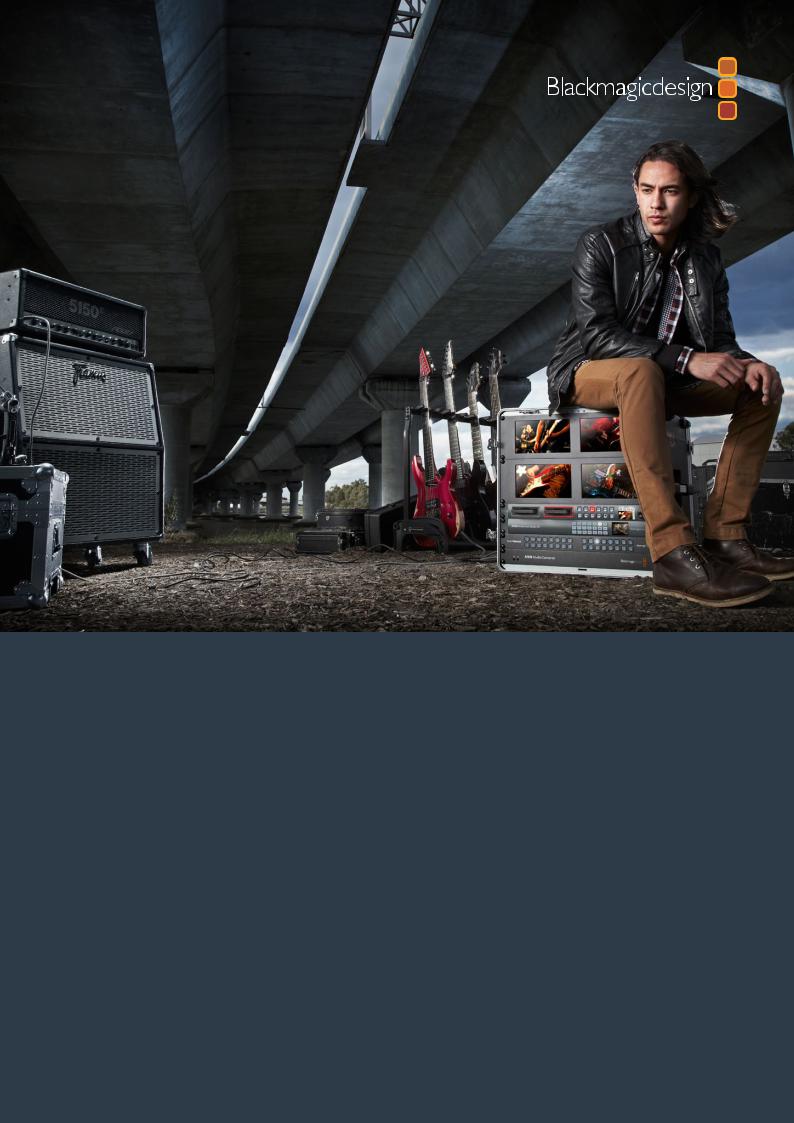
Installation and Operation Manual
HyperDeck
Disk Recorders
March 2020
English, , Français, Deutsch, Español, ,, Русский, Italiano, Português and Türkçe.

Languages
To go directly to your preferred language, simply click on the hyperlinks listed in the contents below.
English |
3 |
|
82 |
Français |
162 |
Deutsch |
244 |
Español |
324 |
|
404 |
|
484 |
Русский |
564 |
Italiano |
644 |
Português |
724 |
Türkçe |
804 |

Welcome
We hope you share our dream for the television industry to become a truly creative industry by allowing anyone to have access to the highest quality video.
Our range of HyperDeck disk recorders have made it easier and more affordable than ever to record and play back full 10 Bit uncompressed video and now Ultra HD! HyperDeck records directly to removable 2.5" Solid State Disks (SSDs) and SD cards that are getting bigger, faster and more affordable every day. It’s incredible that you can now record and play the most amazing quality video onto something so small thousands of times without any degradation in quality!
SSDs and SD cards can also be connected to any computer for immediate editing and fast transfer of your media. With no moving parts, they are unbelievably robust and can handle harsh conditions that would destroy conventional hard drives and videotapes!
You can bypass unwanted camera compression and record directly from HDMI or SDI cameras and even connect to any HDMI or SDI monitor for instant playback. The HyperDeck Studio Mini model is a small and portable, modular Ultra HD disk recorder that records on tiny SD cards. With HyperDeck Studio Pro, you can connect analog sources and also record and play back Ultra HD with 6G-SDI. The HyperDeck Studio 12G model can record even higher frame rates
in Ultra HD up to 60 fps!
If you need longer recording times, then HyperDeck also records and plays back Apple ProRes and Avid DNx files. These 10 Bit quality codecs retain fantastic picture quality and increase the recording length of your media by more than 5 times!
This instruction manual contains all the information you need to start using your HyperDeck disk recorder. For uncompressed recording you need to use an SSD that supports the required data speed and we are continually adding details on our website of new SSDs that we have tested.
Please check the support page at www.blackmagicdesign.com for the latest version of this manual and updates to the HyperDeck software. Keeping your software up to date will always ensure you get all the latest features. When downloading software, please register with your information so we can keep you updated when new software is released. We are constantly working on new features and improvements, so we would love to hear from you!
Grant Petty
CEO Blackmagic Design
Contents
HyperDeck Disk Recorders
Getting Started |
|
5 |
Recording |
|
7 |
Playback |
|
10 |
HyperDeck Status Indicators |
|
13 |
About SSDs and SD Cards |
|
14 |
Blackmagic HyperDeck Setup |
|
21 |
Selecting Your Video Format |
|
22 |
Choosing a Codec |
|
23 |
Control Panel Display Menu |
|
26 |
Trigger Recording |
|
27 |
RS-422 Control |
|
29 |
Transferring Files over a Network |
|
35 |
Connecting to an ATEM Switcher |
|
37 |
Understanding Post |
|
|
Production Workflows |
|
38 |
Using DaVinci Resolve |
|
39 |
Project Manager |
|
39 |
Editing with the Cut Page |
|
40 |
Adding Clips to the Timeline |
|
43 |
Editing Clips on the Timeline |
|
44 |
Adding Titles |
|
44 |
Color Correcting your Clips with |
|
|
the Color Page |
|
45 |
Adding a Power Window |
|
48 |
Using Plugins |
|
50 |
Mixing Your Audio |
|
51 |
Adding VFX and Compositing on |
|
|
the Fusion Page |
|
55 |
Mastering Your Edit |
|
64 |
Quick Export |
|
64 |
The Deliver Page |
|
65 |
Developer Information |
|
66 |
Blackmagic HyperDeck Ethernet |
|
|
Protocol |
|
66 |
Protocol Commands |
|
66 |
Protocol Details |
|
69 |
Help |
|
78 |
Regulatory Notices |
|
79 |
Safety Information |
|
80 |
Warranty |
|
81 |

Getting Started
Getting Started with Blackmagic HyperDeck
Getting started with your HyperDeck disk recorder is as easy as connecting power, plugging in your video sources and destination equipment to your HyperDeck’s inputs and outputs and inserting your SSDs or SD cards.
Plugging in Power
Simply plug a standard IEC cable to your HyperDeck’s power input on the rear panel.
POWER |
REMOTE |
ETHERNET
IN OUT
HDMI
Connect power to your HyperDeck Studio using a standard IEC power cable
You can also power your HyperDeck Studio Mini via Ethernet by plugging into a compatible Ethernet switch that supports PoE+, or ‘power over Ethernet plus’.
USB-C |
REF OUT |
ETHERNET PoE+ |
REF IN |
A |
B |
HDMI OUT |
SDI OUT |
REMOTE IN |
SDI IN |
Connect power to your HyperDeck Mini using a standard IEC power cable.
Power can also be supplied via a PoE+ compatible Ethernet switch.
Plugging in Video and Audio
Plug your source video to the SDI or HDMI inputs, and your destination equipment to the SDI or HDMI outputs.
HyperDeck Studio 12G has 12G-SDI connectors so you can input or output Ultra HD up to 2160p60 using a single BNC cable.
HyperDeck Studio Pro provides additional inputs and outputs for connecting video equipment that supports single link, dual link or quad link Ultra HD.
Getting Started |
5 |
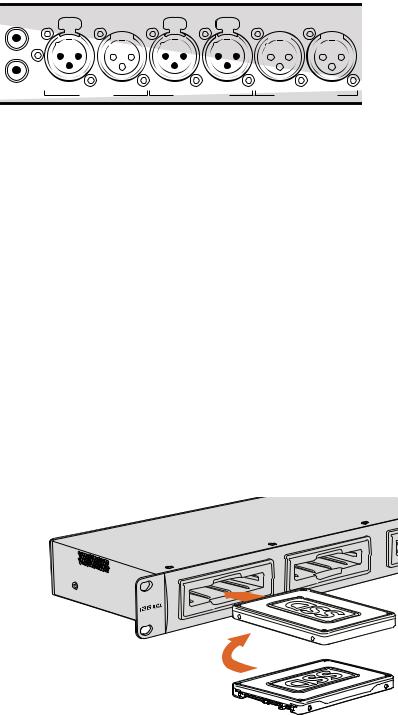
Plugging in Analog Audio and Timecode on HyperDeck Studio Pro
If you want to connect analog audio sources to HyperDeck Studio Pro, plug into the XLR or RCA connectors. To select your desired audio input, simply press the ‘input’ button on the front control panel to cycle through combinations of video and audio inputs. For example, SDI + XLR, SDI + RCA, and more. External timecode can also be connected to and from your HyperDeck Studio Pro via the timecode XLR input and output connectors.
STEREO IN |
PUSH |
|
PUSH |
PUSH |
|
|
|
L |
|
|
|
|
|
|
R |
|
|
|
|
|
|
IN |
OUT |
CH 1 |
CH 2 |
CH 1 |
CH 2 |
|
|
TIMECODE |
ANALOG AUDIO IN |
ANALOG AUDIO OUT |
||
HyperDeck Studio Pro lets you plug in external analog audio and timecode via the rear panel XLR connectors. You can even plug in analog audio from audio equipment such as iPods and HiFi systems via the RCA inputs.
Plugging in SSDs and SD Cards
All HyperDeck models ship ready to record immediately without having to configure any settings. All you need is a formatted SSD or SD card.
You can easily format media via the front LCD based menu settings. You can also format using a computer.
Refer to the ‘About SSDs and SD Cards’ section in this manual for more information on how to format, the types of media that are best for recording video and a list of recommended drives and cards.
To plug in an SSD:
1Hold a 9.5mm SSD with the connection pins facing the bottom and aligned with your HyperDeck’s drive bay. Gently push the SSD into the drive bay until you feel it slot into place.
2Your HyperDeck will verify the SSD. This is shown by an illuminated green light surrounding the drive bay. When the light or indicator turns off and the ‘stop’ button on the control panel is illuminated, your HyperDeck is ready to record.
Hold your SSD with the connection pins facing the bottom, aligned with your HyperDeck’s drive bay and gently push the SSD into the drive bay until you feel it slot into place
Getting Started |
6 |
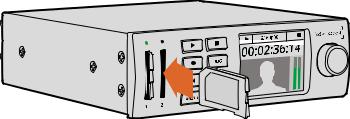
To plug in an SD card:
1Hold the SD card with the gold connectors facing your HyperDeck’s LCD and align it with the media slot. Now gently push the card into the slot until you feel it lock firmly into place.
2Your HyperDeck will verify the SD card. This is shown by an illuminated green indicator above the SD card slot. When the indicator turns off and the stop button on the control panel is illuminated, your HyperDeck is ready to record.
To remove the card, gently push until you feel it click, then release. The card will eject a short distance, allowing you to hold the edge of the card and remove it from the slot.
Card 1
Gently push the SD card into the slot until you feel it click into place
Recording
Recording Ultra HD and HD video with HyperDeck
HyperDeck models that support Ultra HD video record compressed Ultra HD using Apple ProRes, plus Avid DNxHR on HyperDeck Studio 12G and HyperDeck Studio Mini. All HyperDeck models can record HD video using ProRes and DNxHD 220x codecs. HyperDeck Studio models that record on SSDs can also record uncompressed HD.
Recording Video with HyperDeck Studio Mini
HyperDeck Studio Mini can record compressed HD and Ultra HD video up to 2160p30 via 6G-SDI.
To record video:
1Insert your formatted SD card into either of the SD card slots. The indicator above the slot will illuminate green as your HyperDeck reads the card. When the indicator turns off, HyperDeck Studio Mini is ready to record.
2HyperDeck Studio Mini automatically detects when SDI video is connected and displays the image on the control panel LCD.
If you want to change the codec, you can choose from a variety of codecs using the control panel LCD menu or the Blackmagic HyperDeck Setup utility software. For more information, refer to the ‘control panel display menu’ section, or ‘Blackmagic HyperDeck Setup/selecting your video format’.
3Press the ‘record’ button and the indicator above the slot will illuminate red.
As your HyperDeck is recording, the slot indicator on the control panel LCD will alternate between displaying the active slot, and record time remaining on the card.
4Press the ‘stop’ button to finish recording.
Recording 7
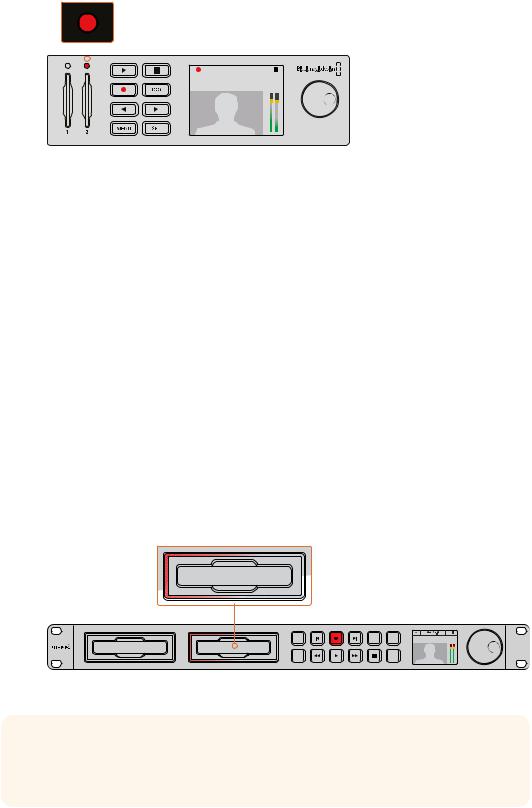
2160p30 |
Card 2 |
01:23:47:08
The indicator above the SD card slot illuminates red when recording video
Recording Video with HyperDeck Studio SSD Models
1Insert your formatted SSD into either SSD slot. The LED strip surrounding the drive will illuminate green as HyperDeck reads the disk. When the slot light turns off, your HyperDeck is ready to record.
2Press the input button on the control panel to cycle through your HyperDeck’s inputs. When your connected source is selected, it will appear on the control panel LCD.
For HyperDeck Studio Pro, pressing the input button will also cycle through combinations of video and audio connections, for example SDI + SDI, SDI + XLR, and SDI + RCA. This lets you record SDI or HDMI video with external audio.
If you want to record using a different codec, you can choose from a variety of codecs using the control panel LCD menu or the HyperDeck Setup utility software. See the ‘control panel display menu’ section, or ‘Blackmagic HyperDeck Setup/selecting your video format’ section for more information.
3Press the ‘record’ button to start recording instantly. A looping red light on the SSD slot indicates the SSD is recording.
4Press the ‘stop’ button to finish your recording.
|
|
|
SSD 2 |
DISP |
INPUT |
REM |
01:42:56:12 |
SET |
|
JOG |
|
On HyperDecks with SSD slots, the slot indicator will illuminate red to show the unit is recording
TIP If HyperDeck records from a video source that contains closed caption data, the QuickTime or MXF movie will be recorded as well as a separate .MCC file containing the closed caption data.
Recording 8

Recording using Dual Media Slots
When there is less than 3 minutes of record time remaining on your SD card or SSD, the timecode counter on your HyperDeck’s LCD will turn red and the ‘stop’ button will flash slowly.
This also means there is no second disk with space that recording can continue onto. In this case, you simply need to insert a disk with space so recording can continue. Once you insert a blank disk into the slot that’s not being used for recording, the slow flashing will stop and this means HyperDeck can continue to record, because this second disk has been checked ok and there is space to keep recording.
SSD 2 |
1 2 |
01:42:56:12 |
01:42:56:12 |
If you have less than three minutes of recording time left on your current disk and no formatted media in your HyperDeck’s second slot, the timecode indicator will turn red indicating your recording is about to stop.
If there is space on a formatted disk in the second slot, HyperDeck will display an icon in the top right corner to indicate that recording will automatically switch over once the current disk is full.
If you want to change the disk you are recording to at any time, and you have a second disk that has free space, then simply hold down the record button and the recording will move from the current disk to the second disk. This is very useful when you want to get that disk out of the HyperDeck without pausing recording. This can happen during live events when you need to get an important recording out to another location, but you don’t want to miss anything and you don’t want to stop recording.
If the ‘record’ button flashes quickly, this means the disk is not fast enough for sustained recording. In this case, if you are recording uncompressed HD, we recommend changing to a compressed recording format such as ProRes or DNxHD, or if you are recording compressed video and the record button flashes quickly, try using faster recommended media.
Ref Input
If your HyperDeck has a reference input, it can accept black burst and tri-level sync signals from a sync generator. Connect a reference source to this input if you want to synchronize HyperDeck with other video equipment, such as a production switcher.
REF IN
|
IN |
LOOP OUT |
OUT 1 |
OUT 2 |
MON OUT |
REF IN |
|
|
|
|
|
|
|
IN |
OUT |
REMOTE |
ETHERNET |
|
SD/HD/3GHD-SDI |
|
|
|
HDMI |
If your HyperDeck has a reference input, you can sync your HyperDeck with other video equipment
Recording 9
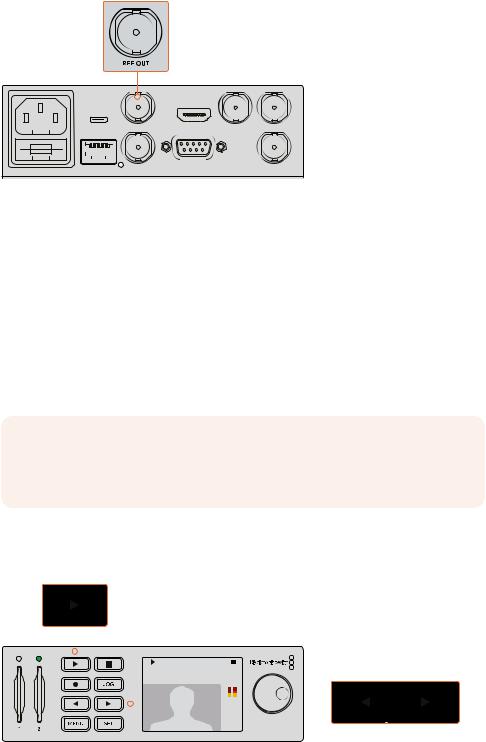
Ref Output
The reference output on HyperDeck Studio Mini lets you connect an internally generated black burst or tri-level sync signal to other video equipment if you want to synchronize other equipment with your HyperDeck.
|
|
A |
B |
USB-C |
REF OUT |
HDMI OUT |
SDI OUT |
ETHERNET PoE+ |
REF IN |
REMOTE IN |
SDI IN |
On HyperDeck Studio Mini you can sync other video equipment with your HyperDeck using the reference output
Playback
Playing Video with HyperDeck
1Press the ‘play’ button once for instant playback and you’ll see your video on the LCD, and any displays connected to your HyperDeck’s video outputs. When a clip is playing, pressing ‘play’ again will loop it continuously. On HyperDeck Studio Mini, pressing play a third time will let you loop all recorded clips.
NOTE With HyperDeck Studio Pro, you can choose to play back Ultra HD using single link, dual link or quad link outputs. Refer to ‘Ultra HD Playback on HyperDeck Studio Pro’ later in this section.
2To skip to the next clip, press the ‘next clip’ button on the control panel.
3Press ‘previous clip’ once to go to the start of the current clip or press twice to skip back to the start of the previous clip.
1080p59.94 |
Card 2 |
01:23:47:08
Press the play button on your HyperDeck’s control panel to play back a clip, and press the forward or reverse skip buttons to restart the current clip or skip to a different one
Playback 10
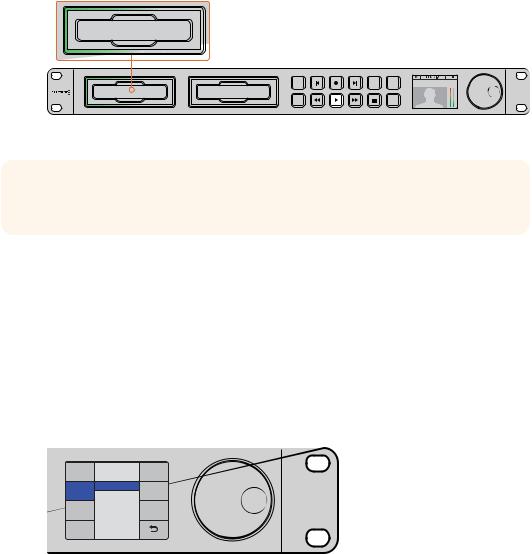
If the play button flashes on HyperDecks that record on SSDs, this means the disk is not fast enough and playback cannot keep up. We recommend you change to a compressed recording format such as ProRes or DNxHD, or use a faster recommended SSD for uncompressed or Ultra HD recording.
|
|
|
SSD 2 |
DISP |
INPUT |
REM |
01:42:56:12 |
SET |
|
JOG |
|
SSD slots have rotating LEDs to show the unit is in playback mode
TIP If you play back a video clip that has an associated .MCC file, the closed caption data will be played out with the video via the SDI output of your HyperDeck.
Ultra HD Playback on HyperDeck Studio Pro
HyperDeck Studio Pro can play back Ultra HD video via single link 6G-SDI, dual link 3G-SDI, and quad link HD-SDI.
To select your desired Ultra HD playback output:
1Press the ‘disp’ button to open the control panel LCD menu.
2Using the jog/shuttle wheel and ‘set’ button, select ‘video’, then ‘2160p SDI out’.
3Select your desired output type and press ‘set’ to confirm. Press the ‘disp’ button to close the menu.
Video In |
2160p SDI Out |
4K SDI Out
 Single 6G-SDI
Single 6G-SDI
Dual 3G-SDI
Quad HD-SDI
For HyperDeck Studio Pro, you can choose between single link 6G-SDI, dual link 3G-SDI or quad link HD-SDI for Ultra HD playback
Jog or Shuttle
You can use the jog or shuttle wheel to shuttle to a particular section at variable speeds.
The more you turn it forwards or backwards, the faster your HyperDeck Studio will play through your video. Once you’ve found the section you want to review, press ‘play’ to resume
normal playback.
If you want to slowly jog through your video frame by frame, press the ‘jog’ button once to enable jog operation. Turning the jog or shuttle wheel in the desired direction will then jog through your video. Pressing the ‘jog’ button again will return the wheel to shuttle operation.
Playback 11

If your HyperDeck has ‘reverse’ or ‘fast forward’ buttons, you can press these buttons to play through the clip at 2x speed. Press the ‘reverse’ or ‘fast forward’ buttons again and the speed will increase to 4x and then 8x. Once you’ve found the section you want to review, press ‘play’ to resume normal playback.
|
|
|
SSD 2 |
DISP |
INPUT |
REM |
01:42:56:12 |
|
|||
SET |
|
JOG |
|
On HyperDecks with fast forward and reverse buttons, press the buttons repeatedly to gradually shuttle playback forwards and backwards at faster speeds
HDR Playback on HyperDeck Studio 12G
HyperDeck Studio 12G is capable of playing back HDR wide gamut video content. This lets you monitor HDR video on an HDMI TV or SDI monitor. For example, you may have HDR files you have exported from a DaVinci Resolve workstation and want to view them on a larger screen or HDMI projector.
Your HyperDeck will automatically read the metadata in the clip file and select the corresponding HDR output format.
While the auto setting will be successful most of the time, some files may not include the required metadata, and this may affect how the brightest regions of your image will be displayed. If the image does not appear as expected, you can set the correct output format using the ‘HDR’ LCD menu.
To set the HDR output format:
1Press the ‘menu’ button to open the LCD menu.
2Navigate to the ‘video’ menu and select ‘HDR’.
3Select the video clip’s corresponding HDR output format from the list. For example, if your clip was encoded for HDR 10 using ST2084 at 2000 nits, select ST2084 (2000).
NOTE For HDR playback to work as expected, the monitor or HDMI projector connected to your HyperDeck Studio 12G must also be capable of displaying HDR content.
The HDR output settings available are:
Auto
Auto is the default setting that will let HyperDeck automatically select the output format that conforms to the clip’s HDR metadata.
Rec.709
For high definition video using standard dynamic range.
Playback 12

Rec.2020 SDR
This setting is used for Ultra HD video using standard dynamic range.
HLG
HLG stands for ‘hybrid log gamma’. This format allows HDR video to be played back on HDR capable TVs and monitors, including those that support up to Rec.2020 SDR.
The following settings support the Rec.2020 color gamut, plus PQ, or perceptual quantizer published as SMPTE ST2084. PQ is the function of wide gamut HDR that allows for the display of brighter images. Luminance values in candelas per meter squared, for example 1000 cd/m2 indicate the maximum luminance per square meter supported by the corresponding format.
ST2084 (300)
300 cd/m2 luminance.
ST2084 (500)
500 cd/m2 luminance.
ST2084 (800)
800 cd/m2 luminance.
ST2084 (1000)
1000 cd/m2 luminance.
ST2084 (2000)
2000 cd/m2 luminance.
ST2084 (4000)
4000 cd/m2 luminance.
HyperDeck Status Indicators
Status Indicators
When recording or playing video with HyperDeck, any information you need to know is displayed on the unit itself via LED indicators for each media slot and the built in LCD.
Media Slot Indicators
When you first power on HyperDeck, or any time you insert an SSD or SD card, the slot indicator will illuminate green while checking the media and then switch off. If the disk has not been formatted correctly, or fails to work, the slot will illuminate solid red until the disk is removed. In this case, check if the disk is formatted correctly and also check that it works with a computer.
2160p30 |
Card 2 |
01:23:47:08
HyperDeck’s media slot indicators illuminate to let you know the status of the disk, for example red when recording, and green during playback
HyperDeck Status Indicators |
13 |
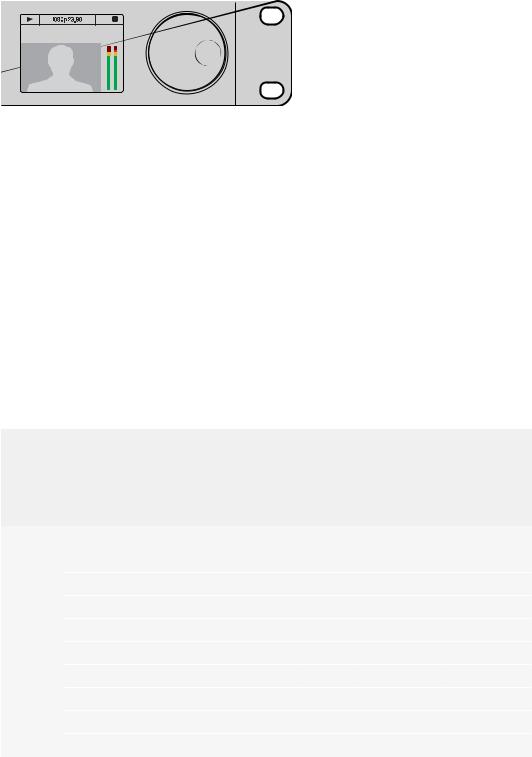
Control Panel LCD
HyperDeck Disk Recorders feature an LCD that not only shows your video but also displays status information such as video format and frame rate, record, playback and jog modes, the active media slot as well as timecode and audio levels.
SSD 1
01:42:56:12
HyperDecks have a built in LCD that shows your video as well as status information
About SSDs and SD Cards
Choosing a Fast SSD
When working with high data rate video it’s important to carefully check the SSD you would like to use. This is because some SSDs can have up to 50% lower write speed than the manufacturer’s claimed speed, so even though the disk specifications claim an SSD is fast enough to handle video, in reality the disk is not fast enough for real time video recording. Hidden data compression mostly affects recording and often these disks can still be used for real time playback.
In our testing, we have found larger newer models of SSD and larger capacity SSDs are generally faster. SSDs recommended for use with HyperDeck for uncompressed 10 Bit HD and ProRes or DNxHR Ultra HD video recording include:
Brand |
SSD Name/Model Number |
Storage |
Supported Formats |
|
|
|
|
|
|
|
|
|
10-bit |
|
|
|
|
uncompressed |
|
|
|
|
HD and Ultra HD |
HD ProRes |
|
|
|
ProRes or DNxHR |
and DNxHD |
|
|
|
|
|
ADATA |
XPG SX900 |
256GB |
Yes |
Yes |
|
|
|
|
|
|
250 GB AV Pro (not HyperDeck Shuttle) |
250GB |
Yes |
Yes |
|
500 GB AV Pro (not HyperDeck Shuttle) |
500GB |
Yes |
Yes |
|
AVP250MK3 AP2A4CT |
250GB |
Yes |
Yes |
|
AVP500MK3 A2GMX52 |
500GB |
Yes |
Yes |
Angelbird |
AV PRO XT |
500GB |
Yes |
Yes |
|
AV PRO XT |
1TB |
Yes |
Yes |
|
AV PRO XT |
2TB |
Yes |
Yes |
|
AV PRO |
250GB |
Yes |
Yes |
|
AV PRO |
500GB |
Yes |
Yes |
|
|
|
|
|
About SSDs and SD Cards |
14 |

Brand |
SSD Name/Model Number |
Storage |
Supported Formats |
||
|
|
|
|
|
|
|
|
|
10-bit |
|
|
|
|
|
uncompressed |
|
|
|
|
|
HD and Ultra HD |
HD ProRes |
|
|
|
|
ProRes or DNxHR |
and DNxHD |
|
|
|
|
|
|
|
Crucial |
M4 (firmware 009 only) CT512M4SSD2 |
512GB |
No |
Yes |
|
M4 (firmware 000F only) CT256M4SSD2 |
256GB |
No |
Yes |
||
|
|||||
|
|
|
|
|
|
|
4K Professional Video Series (DIG-PVD1000, pre- |
1TB |
Yes |
Yes |
|
|
formatted ExFat) |
||||
|
|
|
|
||
Digistor |
Professional Video Series (DIG-PVD240S, pre- |
240GB |
Yes |
Yes |
|
formatted ExFat) |
|||||
|
|
|
|
||
|
Professional Video Series (DIG-PVD480S, pre- |
480GB |
Yes |
Yes |
|
|
formatted ExFat) |
||||
|
|
|
|
||
|
|
|
|
|
|
|
335 Series SSDSC2CT240A4K5 |
240GB |
Yes |
Yes |
|
|
520 Series SSDSC2CW240A310 |
240GB |
Yes |
Yes |
|
Intel |
520 Series SSDSC2CW480A310 |
480GB |
Yes |
Yes |
|
|
530 Series SSDSC2BW180A401 |
180GB |
Yes |
Yes |
|
|
530 Series SSDSC2BW240A401 |
240GB |
Yes |
Yes |
|
|
|
|
|
|
|
|
HyperX 3K SH103S3/240G |
240GB |
Yes |
Yes |
|
|
Now KC300 SKC300S37A/240G |
240GB |
Yes |
Yes |
|
|
HyperX 3K SH103S3/480G |
480GB |
Yes |
Yes |
|
|
HyperX Savage SHSS37A/120G |
120GB |
Yes |
Yes |
|
Kingston |
HyperX Savage SHSS37A/240G |
240GB |
Yes |
Yes |
|
|
HyperX Savage SHSS37A/480G |
480GB |
Yes |
Yes |
|
|
HyperX Savage SHSS37A/960G |
960GB |
Yes |
Yes |
|
|
KC400 |
128GB |
Yes |
Yes |
|
|
KC400 |
256GB |
Yes |
Yes |
|
|
|
|
|
|
|
OCZ |
Agility 3 AGT3-25SAT3-240G |
240GB |
No |
Yes |
|
|
|
|
|
|
|
|
Mercury Extreme Pro 6G OWCSSD7P6G120 |
120GB |
Yes |
Yes |
|
OWC |
Mercury Extreme Pro 6G OWCSSD7P6G240 |
240GB |
Yes |
Yes |
|
|
Mercury Extreme Pro 6G OWCSSD7P6G480 |
480GB |
Yes |
Yes |
|
|
|
|
|
|
|
|
Prevail SSD9SC240GCDA-PB |
240GB |
Yes |
Yes |
|
PNY |
Prevail SSD9SC480GCDA-PB |
480GB |
Yes |
Yes |
|
|
XLR8 SSD9SC480GMDA-RB |
480GB |
Yes |
Yes |
|
|
|||||
|
|
|
|
|
|
About SSDs and SD Cards |
15 |

Brand |
SSD Name/Model Number |
Storage |
Supported Formats |
||
|
|
|
|
|
|
|
|
|
10-bit |
|
|
|
|
|
uncompressed |
|
|
|
|
|
HD and Ultra HD |
HD ProRes |
|
|
|
|
ProRes or DNxHR |
and DNxHD |
|
|
|
|
|
|
|
|
850 Pro MZ-1T0BW, spacer required) - not |
1TB |
Yes |
Yes |
|
|
compatible with HyperDeck Shuttle |
||||
|
|
|
|
||
|
850 Pro MZ-7KE256BW, spacer required |
256GB |
Yes |
Yes |
|
|
850 Pro MZ-7KE512BW, spacer required |
512GB |
Yes |
Yes |
|
|
860 EVO - not compatible with HyperDeck |
2TB |
Yes |
Yes |
|
|
Shuttle |
||||
|
|
|
|
||
|
860 EVO - not compatible with HyperDeck |
4TB |
Yes |
Yes |
|
|
Shuttle |
||||
|
|
|
|
||
Samsung |
860 EVO V-NAND MZ-76E250 |
250GB |
Yes |
Yes |
|
|
|||||
|
860 EVO V-NAND MZ-76E1T0 |
1TB |
Yes |
Yes |
|
|
860 EVO V-NAND MZ-76P256 |
256GB |
Yes |
Yes |
|
|
860 EVO V-NAND MZ-76P512 |
512GB |
Yes |
Yes |
|
|
860 EVO V-NAND MZ-76P1T0 |
1TB |
Yes |
Yes |
|
|
860 EVO V-NAND 500GB MZ-76E500 |
500GB |
No |
Yes |
|
|
850 Pro |
2TB |
Yes |
Yes |
|
|
|
|
|
|
|
|
Extreme SDSSDX-240G-G25 |
240GB |
Yes |
Yes |
|
Sandisk |
Extreme SDSSDX-480G-G25 |
480GB |
Yes |
Yes |
|
|
Extreme SDSSDX-120G-G25 |
120GB |
No |
Yes |
|
|
|
|
|
|
|
Sony |
G series Professional SSD SV-GS48 |
480GB |
Yes |
Yes |
|
G series Professional SSD SV-GS96 |
960GB |
Yes |
Yes |
||
|
|||||
|
|
|
|
|
|
Transcend |
TS256GSSD370BM |
256GB |
Yes |
Yes |
|
|
|
|
|
|
|
Please visit the Blackmagic Design support center at www.blackmagicdesign.com for the latest support notes and information. If you find an SSD that isn’t fast enough for uncompressed HD video or Ultra HD, try a faster SSD or switch to a compressed recording format such as ProRes or DNxHD. These recording formats have a much lower data rate and are easier for
the SSD to handle.
Choosing a fast SD Card
For high quality HD recording on HyperDeck Studio Mini, we recommend high speed UHS-II SD cards. These cards need to be capable of write speeds above 110MB/s for recording up to Ultra HD 2160p30. However, if you are recording standard definition or lower bit rate, lower quality compression you might be able to use slower cards. Generally the faster the cards, the better.
It’s worth regularly checking the latest version of this manual for more up to date information and can always be downloaded from the Blackmagic Design website at www.blackmagicdesign.com/support
About SSDs and SD Cards |
16 |
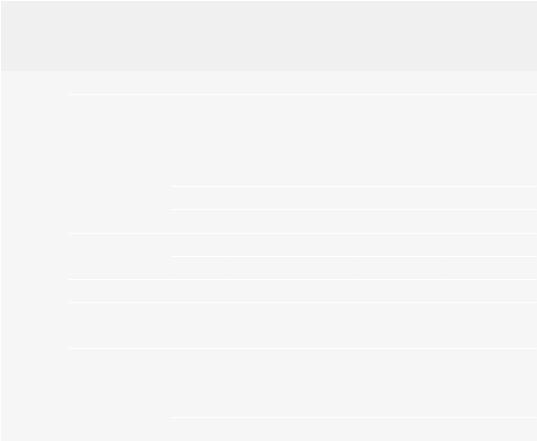
Brand |
Card Name |
Storage |
Max Read/Write Speed |
Supported Formats |
||
|
|
|
|
|
|
|
|
|
|
|
Ultra HD ProRes |
HD ProRes, |
|
|
|
|
|
or DNxHR |
DNxHD or H.264 |
|
|
|
|
|
|
|
|
Angelbird |
Angelbird AV Pro |
128GB |
300 MB/s |
Yes |
Yes |
|
Angelbird |
64GB |
300 MB/s |
Yes |
Yes |
||
|
||||||
|
|
|
|
|
|
|
Lexar |
Professional 2000x |
64GB |
300 MB/s |
Yes |
Yes |
|
|
|
|
|
|
|
|
MagicRAM |
MagicRAM V90 |
256GB |
300 MB/s |
Yes |
Yes |
|
|
|
|
|
|
|
|
|
|
128GB |
300 MB/s |
Yes |
Yes |
|
|
Extreme Pro |
64GB |
300 MB/s |
Yes |
Yes |
|
|
|
32GB |
300 MB/s |
Yes |
Yes |
|
Sandisk |
Extreme Pro |
64GB |
95 MB/s |
No |
Yes |
|
|
32GB |
95 MB/s |
No |
Yes |
||
|
|
|||||
|
Extreme |
64GB |
90 MB/s |
No |
Yes |
|
|
Extreme Plus |
64GB |
90 MB/s |
No |
Yes |
|
|
|
|
|
|
|
|
Sony |
Sony SF-G64 |
64GB |
300 MB/s |
Yes |
Yes |
|
Sony SF-G128 |
128GB |
300 MB/s |
Yes |
Yes |
||
|
||||||
|
|
|
|
|
|
|
Toshiba |
Exceria Pro |
256GB |
260 MB/s |
Yes |
Yes |
|
|
|
|
|
|
|
|
Wise |
Wise SD2 |
64GB |
285 MB/s |
Yes |
Yes |
|
128GB |
285 MB/s |
Yes |
Yes |
|||
|
|
|||||
|
|
|
|
|
|
|
Formatting SSDs and SD Cards
Media used by HyperDeck must be formatted as either HFS+ or exFAT. These disk formats allow long clips to be recorded as single files. You can easily format a card or SSD via the format feature in HyperDeck’s LCD menu, or via a Windows or Mac OS computer.
HFS+ is also known as Mac OS Extended and is the recommended format for HyperDeck as it supports journaling. Data on a journaled disk is more quickly recovered in the rare event it becomes corrupted, and less likely to be corrupted in the first place. HFS+ is natively supported by Mac OS.
ExFAT is supported natively by Mac OS and Windows without needing to purchase any additional software. However, exFAT does not support journaling.
While navigating through the format feature on the LCD menu, you’ll have plenty of opportunities to cancel the format and return to the previous menu by selecting the return arrow on the bottom right of the LCD and pressing the ‘set’ button on the control panel, or by pressing the menu button on HyperDeck Studio Mini. Always press the ‘set’ button to confirm settings and enter setting menus.
About SSDs and SD Cards |
17 |
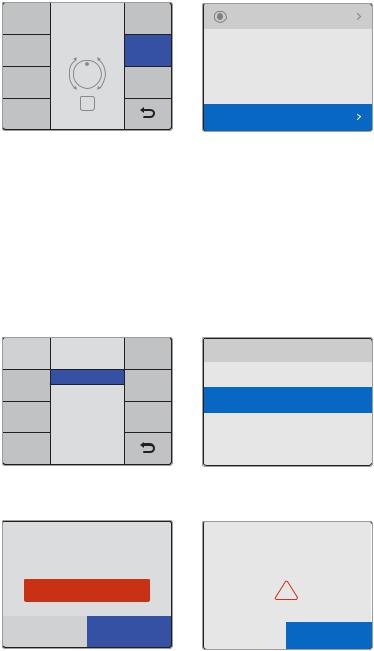
To format using your HyperDeck:
1Insert the media you want to format into either of the SD card or SSD slots.
2Press the ‘disp’ or ‘menu’ button on your HyperDeck’s control panel.
3On HyperDecks that record on SSDs, turn the jog/shuttle wheel and press the set button to select ‘format SSD’ on the LCD menu.
On HyperDeck Studio Mini, turn the jog/shuttle wheel and use the set button to enter the ‘record’ menu on the LCD and select ‘format card’.
Video |
Main Menu |
Setup |
Timecode |
|
Format |
|
|
SSD |
Select
Record
SET
Open
Record
Codec |
ProRes HQ |
|
|
Record Trigger |
None |
|
|
Audio Channels |
4 Channels |
|
|
Format Card |
|
Turn the jog/shuttle wheel clockwise to select ‘format SSD’ on the LCD menu.
On HyperDeck Studio Mini, the ‘format card’ setting is in the ‘record’ menu.
4Select the SD card or SSD you want to format on the LCD using the jog/shuttle wheel. Remember to press the ‘set’ button to confirm your selection.
5Now set your desired format from the ‘HFS+’ or ‘exFAT’ options.
6A warning message will appear on the LCD asking you to confirm the format. Make sure you have backed up any important data before you confirm as this action cannot be undone. Confirm the format by selecting ‘format’ for SD cards, or ‘format SSD’ using the jog/shuttle wheel and pressing the ‘set’ button.
Format |
Format SSD 1 |
Select Format |
SSD 1 |
|
|
Format |
HFS+ |
exFat |
SSD 2 |
exFAT |
|
|
OS X Extended |
|
|
|
Set your desired format from the HFS+ or exFAT options. On HyperDeck
Studio Mini, HFS+ is labeled ‘OS X Extended’
Format SSD 1 as HFS+? |
Format SD 2 to OS X Extended? |
||||
|
|
|
|||
Your disk’s contents will be erased. |
This will erase all data from your card |
||||
This action cannot be undone. |
|
! |
|||
|
|
|
This action cannot be undone. |
||
Cancel |
Format SSD |
|
|
||
Cancel |
Format |
||||
|
|
|
|||
|
|
|
|
|
|
Confirm the format by using the jog/shuttle wheel and pressing the set button
A progress bar will show you the formatting progress. When your HyperDeck has finished formatting, ‘formatting complete’ will display on the LCD. Press the ‘set’ button again to return to the menu.
About SSDs and SD Cards |
18 |

Formatting Media on a Mac OS Computer
The Disk Utility application included with Mac OS can format a drive in the HFS+ or exFAT formats. Make sure you back up anything important from your disk as you will lose everything on it when it is formatted.
To format on a Mac OS computer:
1Connect an SSD to your computer with an external dock or cable adapter and dismiss any message offering to use your SSD for Time Machine backups.
For SD cards, insert the card into your computer’s SD card slot, or connect it to your computer via an external card reader.
2Go to applications/utilities and launch Disk Utility.
3Click on the disk icon of your SSD or SD card and then click the erase tab.
4Set the format to Mac OS Extended (Journaled) or exFAT.
5Type a name for the new volume and then click erase. Your media will quickly be formatted and made ready for use with HyperDeck.
Use Disk Utility on Mac OS to erase your SSD or SD card in the Mac OS Extended (Journaled) or exFAT format
About SSDs and SD Cards |
19 |
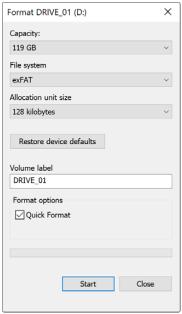
Formatting Media on a Windows computer
The format dialog box can format a drive in the exFAT format on a Windows PC. Make sure you back up anything important from your SSD or SD card as you will lose everything on it when it is formatted.
To format on a Windows computer:
1Connect an SSD to your computer with an external dock or cable adapter.
For SD cards, insert the card into your computer’s SD card slot, or connect it to your computer via an external card reader.
2Open the start menu or start screen and choose computer. Right-click on your SSD or SD card.
3From the contextual menu, choose format.
4Set the file system to exFAT and the allocation unit size to 128 kilobytes.
5Type a volume label, select quick format and click Start.
6Your media will quickly be formatted and made ready for use with HyperDeck.
Use the Format dialog box feature in Windows to format your SSD or SD card in the exFAT format
About SSDs and SD Cards |
20 |
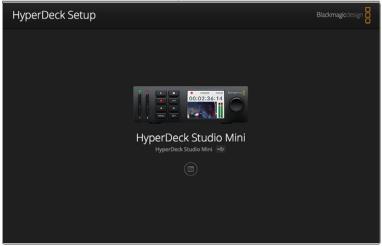
Blackmagic HyperDeck Setup
Using HyperDeck Setup
Blackmagic HyperDeck Setup is used to change settings and update the internal software in your HyperDeck. In addition to installing HyperDeck Setup, uncompressed 10 bit codecs are installed for Mac and Windows.
The home page of HyperDeck Setup. If you have multiple HyperDecks connected to your computer, you can choose between them by clicking on the arrows at the sides of the home page
How to Update Your HyperDeck Software on Mac
1Download and unzip the HyperDeck Setup software.
2Open the resulting disk image and launch the HyperDeck Installer. Follow the onscreen instructions.
3After installing, connect a USB cable from HyperDeck to your computer.
4Launch Blackmagic HyperDeck Setup and follow any onscreen prompt to update the internal software in your HyperDeck. If no prompt appears, the internal software is up to date and there is nothing further you need to do.
How to Update Your HyperDeck Software on Windows
1Download and unzip the HyperDeck Setup software.
2You should see a HyperDeck Setup folder containing this manual and the HyperDeck Setup utility installer. Double-click the installer and follow the onscreen prompts to complete the installation.
3After installing, connect a USB cable from HyperDeck to your computer.
4Launch Blackmagic HyperDeck Setup and follow any onscreen prompt to update the internal software in your HyperDeck. If no prompt appears, the internal software is up to date and there is nothing further you need to do.
Blackmagic HyperDeck Setup |
21 |
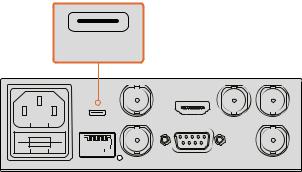
Selecting Your Video Format
All HyperDecks record compressed HD video using Apple ProRes and Avid DNxHD 220x codecs. HyperDeck models that record on SSDs can also record uncompressed HD video.
HyperDeck Studio Pro records Ultra HD using ProRes codecs. HyperDeck Studio Mini and HyperDeck Studio 12G support ProRes and DNxHR HQX for Ultra HD recording.
HyperDeck Studio Mini also records HD video using the H.264 codec, providing much longer record times with cheaper SD media, and offers a wider family of DNx codecs including DNxHD145 and DNxHR SQ.
You can change the codec you want from the front panel LCD menu, or you can use the HyperDeck Setup software utility depending on which you prefer. For more information on how to change your codec using the front panel, refer to the ‘control panel display menu’ section.
HyperDecks that record on SSDs can record 10-bit uncompressed QuickTime files on a fast SSD, or to a compressed format if you have a slower SSD or want to fit longer high definition recordings on a single SSD. You can also change the format between recording clips, making it possible to have uncompressed QuickTime files as well as compressed files on the same disk.
Working with uncompressed video is exciting as there is simply no better quality. However, if compressed video better suits your workflow, or if you need to fit more video on a SSD, you can choose a high quality professional compressed video format which is also perfect for editing.
To choose a video format using HyperDeck Setup:
1Connect HyperDeck to your computer via USB.
2Launch HyperDeck Setup. Your HyperDeck model will be named in the setup utility home page.
3Click on the circular ‘setup’ icon or the image of your HyperDeck to open the settings page.
4In the ‘record’ settings, click on the ‘codec’ drop down menu and select your desired codec. Click ‘save’ to confirm your setting.
USB-C |
|
|
|
|
|
A |
B |
USB-C |
REF OUT |
HDMI OUT |
SDI OUT |
ETHERNET PoE+ |
REF IN |
REMOTE IN |
SDI IN |
To change settings using HyperDeck Setup, plug HyperDeck into your computer via the USB port
Blackmagic HyperDeck Setup |
22 |

Use HyperDeck Setup to select your desired recording and playback format
All subsequent clips will be recorded in the chosen format.
Setting the recording format also sets the playback format. For example, if you want to play back an uncompressed 10-bit QuickTime file, set the recording format to Uncompressed 10-bit QuickTime. Setting Avid DNxHD as the recording format lets you play DNxHD 220x QuickTime and MXF clips, and by selecting Apple ProRes you can play clips using any of the
ProRes codecs.
NOTE Currently, HyperDeck Studio Mini will play back H.264 files recorded on a HyperDeck Studio Mini, but not H.264 files recorded on other video equipment.
Choosing a Codec
Each codec is determined using a balance between video quality, level of compression and resulting file size. The less compression you use the more information you will have in your files for a range of workflows, but there are occasions where storage space requires smaller files. For example, when recording for archival purposes, ProRes 422 Proxy, ProRes LT, DNxHD 45 or DNxHR LB are a good choice as they provide good video quality in a smaller file size.
For short form editorial and color grading workflows, 10-bit codecs such as ProRes 422 HQ, DNxHR HGX or DNxHD 220x are a great choice. They offer the least amount of compression and therefore more latitude in post production, but the files sizes are larger.
ProRes 422, DNxHR SQ or DNxHD 145 work well in long form editorial workflows. These files are smaller but still high enough quality for broadcast delivery and are widely used in post production. HyperDeck Studio Mini can also record OP-1A DNx MXF files allowing multiple tracks of audio to be recorded in the same interleaved file.
Blackmagic HyperDeck Setup |
23 |

For YouTube delivery from HyperDeck Studio Mini, you have the flexibility of three H.264 options, ‘high’, ‘medium’ and ‘low’. When recording H.264, your audio compression will default to 2 channels of AAC audio so you can simply upload your recorded files to YouTube. If you want the benefits of smaller file size but also the flexibility of additional audio channels, you can also record up to 16 channels of PCM audio instead. It’s worth noting that H.264 files will default to record 2 channels of AAC audio, so if you want record PCM audio instead, after selecting your H.264 quality, select ‘audio channels’ in the ‘record’ menu and select how many audio channels you want.
You may decide to experiment to see which format best suits your workflow.
HyperDeck Disk Recorders support the following codecs.
|
|
|
HyperDeck |
HyperDeck |
HyperDeck |
HyperDeck |
Codecs |
|
Bit Depth |
Studio |
Studio Pro |
Studio 12G |
Studio Mini |
|
|
|
|
|
|
|
|
Uncompressed |
10-bit |
Yes |
Yes |
Yes |
No |
|
ProRes 422 HQ |
10-bit |
Yes |
Yes |
Yes |
Yes |
|
ProRes 422 |
10-bit |
Yes |
Yes |
Yes |
Yes |
|
ProRes 422 LT |
10-bit |
Yes |
Yes |
Yes |
Yes |
QuickTime |
|
|
|
|
|
|
|
ProRes 422 Proxy |
10-bit |
Yes |
Yes |
Yes |
Yes |
|
ProRes 4444 |
12-bit |
No |
No |
No |
Yes |
|
(HD playback only) |
|||||
|
|
|
|
|
|
|
|
H.264 |
– |
No |
No |
No |
Yes |
|
(HD recording |
|||||
|
|
|
|
|
|
and playback) |
|
|
|
|
|
|
|
|
Avid DNxHD 220x |
10-bit |
Yes |
Yes |
Yes |
Yes |
|
Avid DNxHD 145 |
8-bit |
No |
No |
No |
Yes |
QuickTime |
Avid DNxHD 45 |
8-bit |
No |
No |
No |
Yes |
|
|
|
|
|
|
|
and MXF |
Avid DNxHR HQX |
10-bit |
No |
No |
Yes |
Yes |
|
||||||
|
Avid DNxHR SQ |
8-bit |
No |
No |
No |
Yes |
|
Avid DNxHR LB |
8-bit |
No |
No |
No |
Yes |
|
|
|
|
|
|
|
MXF files recorded on the HyperDeck Studio Mini are recorded in the OP-1A operational pattern, allowing audio and video to be recorded in a single interleaved file. The HyperDeck Studio Mini supports playing back OP-1A and OP-Atom files.
H.264 on the HyperDeck Studio Mini
Video Format |
Bit Rate Setting |
Bit Rate (Mb/s) |
|
|
|
|
High |
70 |
1080p60 |
Medium |
46 |
|
Low |
22 |
|
|
|
|
High |
65 |
1080p50 |
Medium |
42 |
|
Low |
20 |
|
|
|
Blackmagic HyperDeck Setup |
24 |
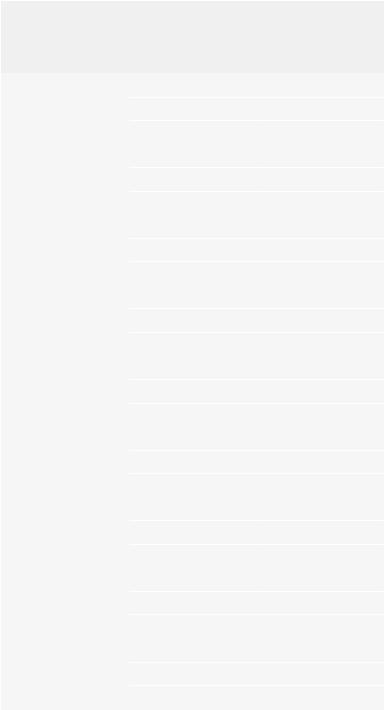
H.264 on the HyperDeck Studio Mini
Video Format |
Bit Rate Setting |
Bit Rate (Mb/s) |
|
|
|
|
High |
45 |
1080p30 |
Medium |
29 |
|
Low |
13 |
|
|
|
|
High |
45 |
1080i60 |
Medium |
30 |
|
Low |
15 |
|
|
|
|
High |
40 |
1080p25 |
Medium |
25 |
|
Low |
11 |
|
|
|
|
High |
40.5 |
1080i50 |
Medium |
27 |
|
Low |
14 |
|
|
|
|
High |
38 |
1080p24 |
Medium |
24 |
|
Low |
10.5 |
|
|
|
|
High |
40 |
720p60 |
Medium |
26 |
|
Low |
12 |
|
|
|
|
High |
33 |
720p50 |
Medium |
21 |
|
Low |
9.5 |
|
|
|
|
High |
10 |
525i59.94 NTSC |
Medium |
7.5 |
|
Low |
4 |
|
|
|
|
High |
10 |
625i50 PAL |
Medium |
7 |
|
Low |
4 |
|
|
|
HyperDeck Studio Mini will play back H.264 files recorded on a HyperDeck Studio Mini, but not H.264 files recorded on other video equipment.
Blackmagic HyperDeck Setup |
25 |
